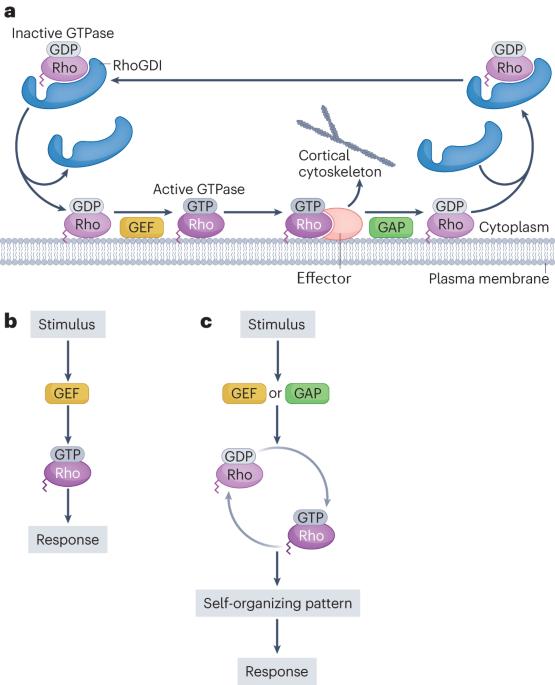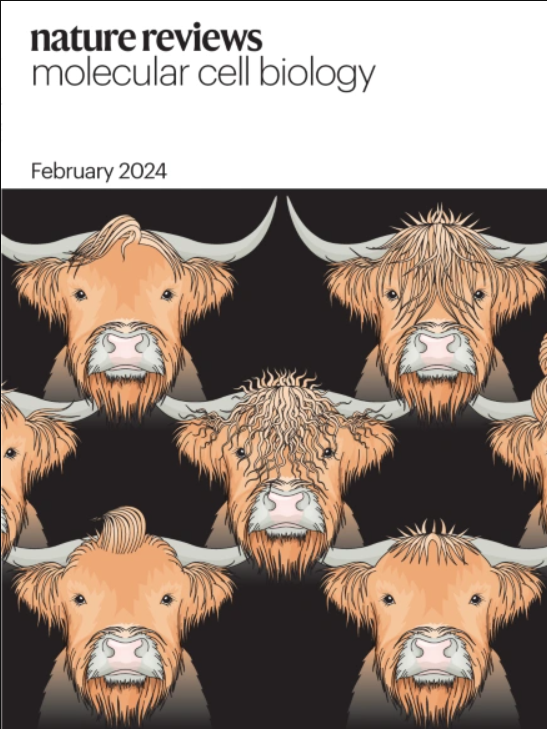Rho GTP酶为细胞皮层绘制图案
IF 81.3
1区 生物学
Q1 CELL BIOLOGY
引用次数: 0
摘要
Rho GTPases(RHOA、RAC1 和 CDC42)是一种小型 GTP 结合蛋白,通过促进细胞皮质中基于细胞骨架的变化来调节细胞运动、细胞分裂和形态发生等基本生物过程。这种调控是活性(GTP 结合)Rho GTP 酶刺激靶蛋白的结果,而靶蛋白反过来又促进肌动蛋白的组装和肌球蛋白 2 的收缩,从而组织皮层。这一基本调控方案得到了体外研究的充分支持,因此人们自然而然地认为,Rho GTPase 在体内的功能基本上是线性的,特定过程由 GTPase 激活启动,并由 GTPase 失活终止。然而,越来越多基于活细胞成像、建模和实验操作的证据表明,Rho GTPase 的激活和失活往往通过基于正反馈和负反馈的信号回路和网络在空间和时间上紧密耦合。在本综述中,我们介绍并讨论了这一证据,并探讨了耦合激活和失活的基本后果之一:Rho GTPase 的自组织能力,即引导自身从低阶状态过渡到高阶状态的能力。我们讨论了 Rho GTPase 自组织如何导致形成多种时空皮层模式,如静态集群、振荡脉冲、游动波列和环状波。最后,我们讨论了 Rho GTPase 自组织和模式形成对细胞功能的优势。本文章由计算机程序翻译,如有差异,请以英文原文为准。


Patterning of the cell cortex by Rho GTPases
The Rho GTPases — RHOA, RAC1 and CDC42 — are small GTP binding proteins that regulate basic biological processes such as cell locomotion, cell division and morphogenesis by promoting cytoskeleton-based changes in the cell cortex. This regulation results from active (GTP-bound) Rho GTPases stimulating target proteins that, in turn, promote actin assembly and myosin 2-based contraction to organize the cortex. This basic regulatory scheme, well supported by in vitro studies, led to the natural assumption that Rho GTPases function in vivo in an essentially linear matter, with a given process being initiated by GTPase activation and terminated by GTPase inactivation. However, a growing body of evidence based on live cell imaging, modelling and experimental manipulation indicates that Rho GTPase activation and inactivation are often tightly coupled in space and time via signalling circuits and networks based on positive and negative feedback. In this Review, we present and discuss this evidence, and we address one of the fundamental consequences of coupled activation and inactivation: the ability of the Rho GTPases to self-organize, that is, direct their own transition from states of low order to states of high order. We discuss how Rho GTPase self-organization results in the formation of diverse spatiotemporal cortical patterns such as static clusters, oscillatory pulses, travelling wave trains and ring-like waves. Finally, we discuss the advantages of Rho GTPase self-organization and pattern formation for cell function. The Rho GTPases are small GTP binding proteins that regulate basic biological processes such as cell locomotion, cell division and morphogenesis by promoting cytoskeleton-based changes in the cell cortex. These different functions are driven by the ability of Rho GTPases to self-organize, forming diverse spatiotemporal cortical patterns.
求助全文
通过发布文献求助,成功后即可免费获取论文全文。
去求助
来源期刊
CiteScore
173.60
自引率
0.50%
发文量
118
审稿时长
6-12 weeks
期刊介绍:
Nature Reviews Molecular Cell Biology is a prestigious journal that aims to be the primary source of reviews and commentaries for the scientific communities it serves. The journal strives to publish articles that are authoritative, accessible, and enriched with easily understandable figures, tables, and other display items. The goal is to provide an unparalleled service to authors, referees, and readers, and the journal works diligently to maximize the usefulness and impact of each article. Nature Reviews Molecular Cell Biology publishes a variety of article types, including Reviews, Perspectives, Comments, and Research Highlights, all of which are relevant to molecular and cell biologists. The journal's broad scope ensures that the articles it publishes reach the widest possible audience.

 求助内容:
求助内容: 应助结果提醒方式:
应助结果提醒方式:


